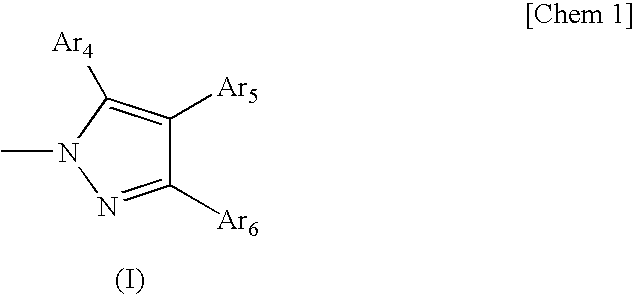Organic Electroluminescent Device
- Summary
- Abstract
- Description
- Claims
- Application Information
AI Technical Summary
Benefits of technology
Problems solved by technology
Method used
Image
Examples
synthetic example 1
In a 2000-ml four-necked flask were placed 13.0 g (0.23 mole) of potassium hydroxide and 1004.5 g of ethanol. The mixture was stirred at room temperature until the potassium hydroxide dissolved and 25.8 g (0.12 mole) of chalcone and 26.4 g (0.24 mole) of phenylhydrazine were added at room temperature. After the addition, the mixture was heated under reflux with stirring for three hours. Upon completion of the reaction, the reaction mixture was cooled to room temperature and a solid was recovered by filtration. The solid was washed with hexane and dried under reduced pressure to give 27.8 g of 1,3,5-triphenylpyrazoline as a white powder.
Then, 156.0 g of acetonitrile was placed in a 500-ml four-necked flask. Thereafter, 60.0 g (0.181 mole) of antimony pentachloride was added in drops over a period of 20 minutes to prevent vigorous generation of heat. After the addition, the mixture was allowed to cool to room temperature and a slurry of 25.0 g (0.084 mole) of the 1,3,5-triphenylpyr...
synthetic example 2
In a 500-ml four-necked flask were placed 21.9 g (0.55 mole) of sodium hydroxide, 100.1 g of methanol, and 195.8 g of deionized water. The mixture was stirred at room temperature until the sodium hydroxide dissolved and 73.8 g (0.43 mole) of 1-acetonaphthone was added. Thereafter, the mixture was cooled by ice water and 48.8 g (0.46 mole) of benzaldehyde was added. After the addition, the mixture was heated under reflux with stirring for three hours. Upon completion of the reaction, the reaction mixture was cooled to room temperature and transferred to a separatory funnel to separate an organic layer. The organic layer was distilled under reduced pressure to remove the solvent and 106.9 g of 1-naphthalen-1-yl-3-phenyl-propenone was obtained as a yellow liquid.
Starting with the 1-naphthalen-1-yl-3-phenyl-propenone, a reaction similar to the one in Synthetic Example 1 was carried out to give 4,4-bis[3-(1-naphthyl)-5-phenylpyrazol-1-yl]biphenyl (hereinafter referred to as a-BNP). Th...
synthetic example 3
The reaction was carried out as in Synthetic Example 2 with the exception of using 30.0 g (0.75 mole) of sodium hydroxide, 104.7 g of methanol, 279.0 g of deionized water, 85.1 g (0.50 mole) of 2-acenaphthone in place of 1-acenaphthone, and 53.1 g (0.50 mole) of benzaldehyde to give 4,4-bis[3-(2-naphthyl)-5-phenylpyrazol-1-yl]biphenyl (hereinafter referred to as β-BNP). The product showed a purity of 99.52% (area ratio, HPLC), a mass of 690, and a melting point of 287.1° C. and corresponds to the compound listed as No. 107.
The sequence of reactions in Synthetic Example 3 is shown below.
The results of the infrared analysis (KBr tablet technique) of β-BNP are shown below.
cm1: 3448, 3052, 1630, 1608, 1504, 1476, 1452, 1412, 1374, 1326, 970, 860, 826, 802, 762, 696, 474, 404
PUM
| Property | Measurement | Unit |
|---|---|---|
| Stability | aaaaa | aaaaa |
| Luminous efficiency | aaaaa | aaaaa |
| Phosphorescence quantum yield | aaaaa | aaaaa |
Abstract
Description
Claims
Application Information
 Login to View More
Login to View More - R&D
- Intellectual Property
- Life Sciences
- Materials
- Tech Scout
- Unparalleled Data Quality
- Higher Quality Content
- 60% Fewer Hallucinations
Browse by: Latest US Patents, China's latest patents, Technical Efficacy Thesaurus, Application Domain, Technology Topic, Popular Technical Reports.
© 2025 PatSnap. All rights reserved.Legal|Privacy policy|Modern Slavery Act Transparency Statement|Sitemap|About US| Contact US: help@patsnap.com



